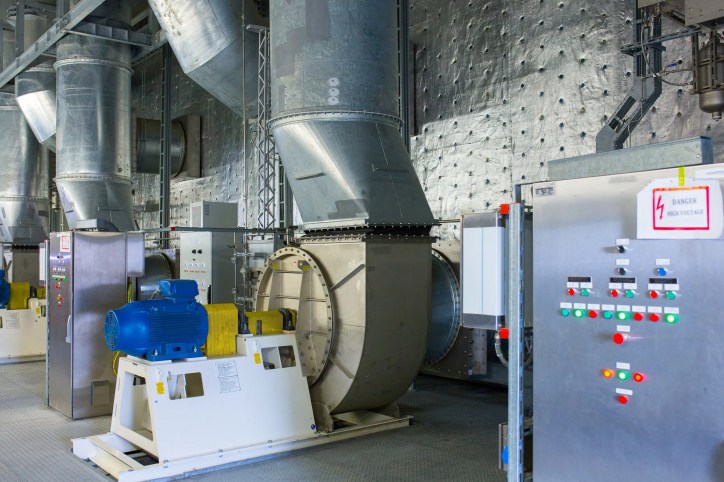Investing in clean indoor air is essential because people spend up to 90% of their time indoors, where pollutant levels can sometimes be higher than outdoors. For residential and commercial buildings, inlet air cleaning equipment, such as air filters, removes allergens, dust, pollen, and other harmful particles from the indoor environment, contributing to better health and a more comfortable atmosphere. ISO 5011:2025—Inlet air cleaning equipment for internal combustion engines and compressors – Performance testing specifies how to test inlet air cleaning equipment for their performance.
What Is Inlet Air Cleaning Equipment?
Healthy indoor quality is attainable due to inlet air cleaning equipment: a device that filters or cleans air as it enters a system—such as an air compressor, engine, fan gas turbine—to prevent contaminants from damaging the equipment or degrading performance.
Inlet air cleaning equipment includes filters (such as HEPA filters), precleaners (using centrifugal force), and industrial devices like fabric collectors, electrostatic precipitators, and wet scrubbers, which use fabric, static electricity, or water to remove pollutants from the air. The goal of these filters is trap dust, debris, and other particles and remove these accumulated contaminants.
What Is ISO 5011:2025?
ISO 5011:2025 establishes and specifies uniform test procedures, conditions, equipment, and a performance report to permit the direct laboratory performance comparison of air cleaners. The basic performance characteristics of greatest interest are airflow restriction or differential pressure, dust collection efficiency, dust capacity, and oil carry-over on oil bath air cleaners. This test code deals with the measurement of these parameters.
This document is applicable to air cleaners used on internal combustion engines and compressors generally used in automotive and industrial applications.
By specifying uniform procedures, conditions, equipment, and performance reports, ISO 5011:2025 assures that the airflow restriction, dust collection efficiency, dust capacity, and oil carry-over of air filters can be accurately measured and directly compared across different laboratories and over time. This allows for quality control, product development, and assurance of reliability in the automotive and industrial sectors. ISO 5011:2025 is critical for assuring that manufacturers and testing labs can reliably evaluate and compare the performance of air filtration systems, no matter the industry or application.
What Is New in the 2025 Edition of ISO 5011?
The 2025 edition of ISO 5011, which tests air-cleaning equipment for internal combustion engines, contains several technical and editorial revisions. This fifth edition replaces the previous version, ISO 5011:2020. The 2025 version incorporates several technical changes intended to streamline testing and improve measurement accuracy. Whether you are a filtration engineer, a testing lab technician, or a manufacturer of air intake systems, this update offers refinements that improve accuracy, streamline testing, and reflect the latest technological advancements.
Notably, ISO 5011:2025 refines how precleaner efficiency is calculated, removes two seldom‑used secondary element tests (collapse and blocking), updates the recommended specifications for the ISO dust injector, and formally validates the absolute filter weighing method. A new Annex H has also been added to introduce a “penetration sensitivity” assessment, offering deeper insight into filter performance under challenging particulate conditions. These changes bring greater clarity, efficiency, and rigor to the standard’s procedures—helping test labs and manufacturers generate more reliable, reproducible data.
The Importance of Inlet Air Cleaning Equipment
Inlet air cleaning equipment is a vital component in protecting and optimizing the performance of engines, compressors, and other machinery. These systems do far more than just filter air—they safeguard equipment, enhance efficiency, and support high-quality output across industries. Here is why they matter:
- Protecting Machinery from Wear and Damage: Inlet filters capture harmful contaminants before they can enter sensitive internal components, preventing abrasive wear, reducing the risk of premature failure, and lowering the frequency of costly repairs.
- Improving Energy Efficiency: Clean filters enable optimal airflow, allowing engines, blowers, and fans to operate efficiently. Clogged or dirty filters force equipment to work harder, increasing energy consumption and reducing overall system performance.
- Extending Equipment Life and Performance: By keeping contaminants away from critical parts, air filtration systems help maintain consistent performance and significantly extend the service life of machinery.
- Reducing Maintenance Costs and Downtime: Preventing internal damage minimizes the need for repairs and part replacements. Regular maintenance of air filters also lowers the risk of unexpected failures, helping maintain continuous, trouble-free operation.
- Ensuring Product Quality: In manufacturing environments, clean inlet air is crucial for preventing contamination of production processes, which could otherwise compromise the quality or integrity of the final product.
Given the critical role inlet air cleaning equipment plays for assuring healthy air quality, implementing ISO 5011:2025 is indispensable. By providing standardized procedures, test conditions, and performance metrics, ISO 5011:2025 assures that manufacturers and testing labs can reliably evaluate and compare air filter performance—regardless of the industry or application. This consistency is key to developing high-quality, reliable air filtration solutions that meet modern performance and environmental demands.
Where to Find ISO 5011:2025
ISO 5011:2025—Inlet air cleaning equipment for internal combustion engines and compressors – Performance testing is available on the ANSI Webstore.
